Transform Your Home with Modern Surrealism in Interior Design
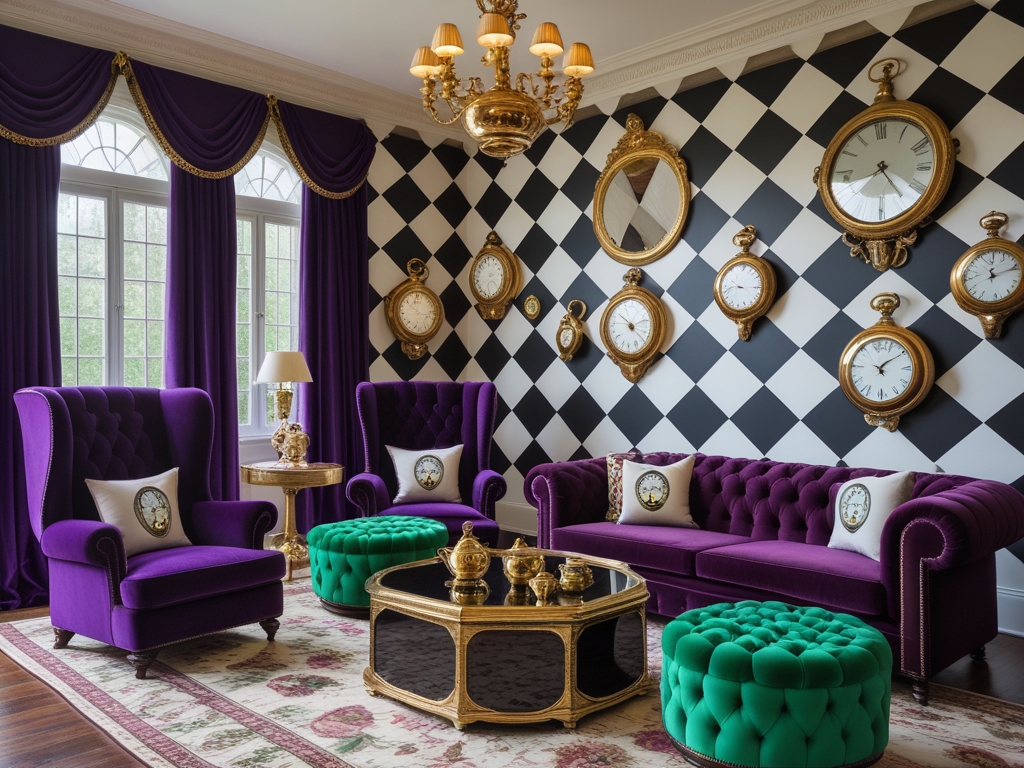
You know that feeling when you walk into a room and something makes you do a double-take – not because it’s wrong, but because it’s wonderfully, intentionally unexpected? That’s what drew me into the world of modern surrealism in interior design. I’ll never forget my first encounter: a mirror that looked like it was melting down the wall at a design show. I stood there for a good five minutes, trying to figure out how they did it. Spoiler alert: I still haven’t figured it out, but I’ve been hooked ever since!
Here’s the thing about modern surrealism in interior design – it’s not about recreating a Dalí painting in your living room (though, how fun would that be?). It’s about finding those perfect moments where reality gets a little playful, where your space tells a story that’s uniquely yours, and where everyday objects become conversation starters.
Think of it as giving yourself permission to break the design rules you’ve always followed. You know those ones: “mirrors have to be perfectly straight,” “furniture should all touch the floor,” “art goes on walls, not around them.” What if I told you that some of the most incredible spaces I’ve seen threw all those rules out their perfectly normal (or delightfully abnormal) windows?
In this guide, we’re going to explore everything from floating furniture to mind-bending lighting, from color combinations that make you question reality to ways of making your outdoor space feel like a dream. Whether you’re ready to dive headfirst into the wonderful world of surreal design or just wanting to dip your toe in with a single statement piece, I’m here to share what I’ve learned – sometimes the hard way! – about making surrealism work in real, livable spaces.
And trust me, if I can recover from that time I installed a “floating” shelf that definitely didn’t float (pro tip: always check your wall anchors), you can absolutely create your own slice of surreal paradise. Ready to make some design magic? Let’s dive in!
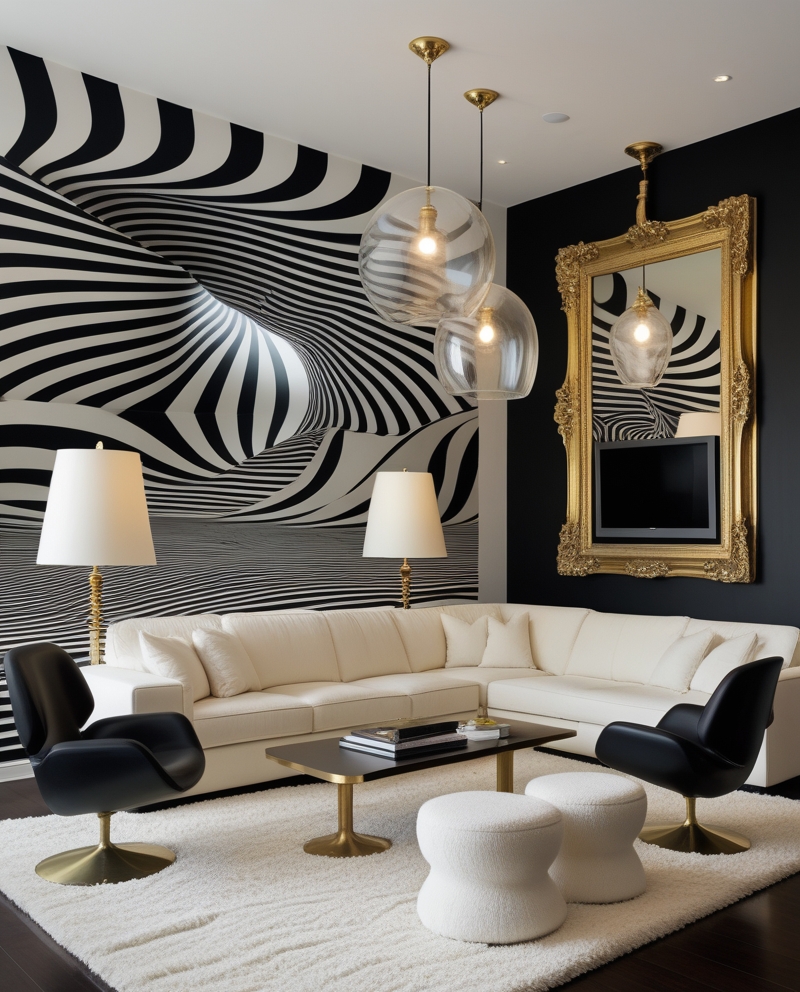
What Is Modern Surrealism in Interior Design?
You know that moment when you walk into a room and do a double-take? Not because something’s wrong, but because something’s wonderfully, intentionally unexpected? That’s modern surrealism in interior design at its finest. It’s like that feeling you get when looking at Salvador Dalí’s melting clocks, except now it’s your coffee table that’s making you question reality (in the best possible way).
Modern surrealism takes its cues from the artistic movement of the 1920s, when artists decided to flip reality on its head and explore the dreamlike and unexpected. But here’s what makes it different in today’s interiors: we’re not just creating spaces that look like abstract paintings – we’re crafting livable, functional rooms that just happen to make you smile, think, or pause in wonder.
Key Elements That Make It Work
Think of modern surrealist design as your permission slip to break the rules – but with purpose. It’s about:
- Playing with scale: Maybe it’s an oversized ceramic hand serving as your side table, or a tiny door that leads to a grand room
- Unexpected materials: Like a velvet-covered concrete bench or a mirror that looks like it’s melting down your wall
- Surprising combinations: Picture a classic Victorian chair, but floating mid-wall as a shelf
The beauty of modern surrealism is that it doesn’t take itself too seriously. Unlike traditional surrealist art, which often aimed to provoke or disturb, today’s surrealist interiors are more about sparking joy and conversation. It’s less about recreating Magritte’s floating apples and more about finding creative ways to make your space uniquely yours.
Finding Your Surrealist Sweet Spot
The trick with modern surrealist design is knowing how to balance the unexpected with the livable. It’s like seasoning a dish – you want enough to make it interesting, but not so much that it overwhelms. Maybe you start with a conventional room layout but add a cloud-shaped sofa, or keep your furniture traditional but play with surreal wallpaper that makes your ceiling look like it opens to the night sky.
The goal isn’t to recreate a museum of surrealist art – it’s about bringing that sense of wonder and playfulness into your everyday space. Whether it’s through optical illusions, surprising material choices, or pieces that challenge perception, modern surrealism gives you permission to think beyond the expected and create spaces that tell your story in an extraordinary way.
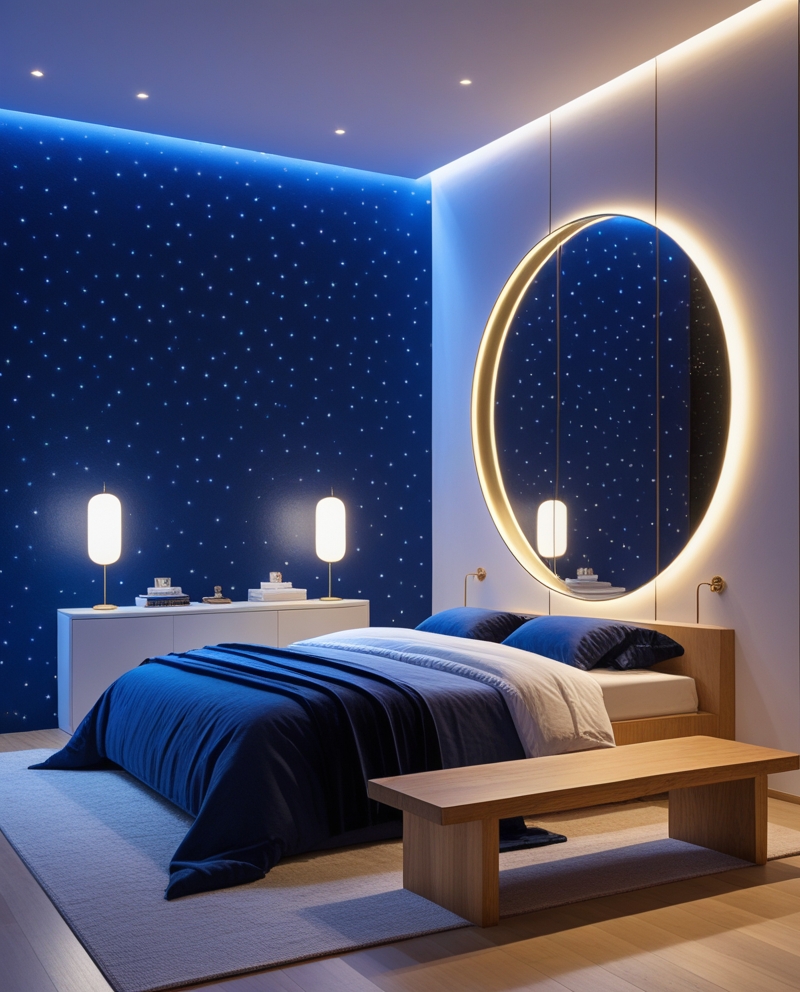
The Core Elements of Surrealist Design
Remember that time you walked into a furniture showroom and saw a chair that looked like it was literally climbing up the wall? That was my first encounter with surrealist design in the wild, and I couldn’t stop thinking about it. Not just because it was striking, but because it made me realize that furniture doesn’t always have to behave the way we expect it to.
Making the Impossible Possible
Let’s talk about what actually makes a space feel surreal. You might think it’s all about hanging melting clocks on your walls (thanks, Dalí!), but there’s so much more to play with:
- Statement pieces that challenge reality: Think chairs that appear to float, tables that look like they’re defying gravity, or mirrors that seem to ripple like water
- Scale play that makes you look twice: Imagine a tiny door leading to your main bedroom, or a lamp so oversized it becomes the room’s focal point
- Unexpected material combinations: Like a concrete coffee table with a plush, velvet surface – trust me, it works!
The Magic of Textures
Here’s something I’ve discovered through experimentation: texture is your secret weapon in surrealist design. You can create visual illusions just by playing with different finishes in unexpected ways. For instance:
- Contrast glossy surfaces with ultra-matte finishes to create depth
- Use metallic elements that seem to change as you move around them
- Layer different tactile experiences – smooth against rough, soft against hard
I once created an accent wall that looked like liquid metal, simply by combining high-gloss paint with strategic lighting. Guests still can’t figure out how it’s done, and honestly? That’s exactly the point.
Lighting: The Ultimate Illusion-Maker
Speaking of lighting – this is where the real fun begins. Lighting in surrealist design isn’t just about illuminating a space; it’s about creating moments of wonder. You can transform an ordinary room into something extraordinary by:
- Playing with shadows to create unexpected patterns
- Using colored lights to alter perception
- Positioning fixtures in unexpected places (yes, that floor lamp can point sideways!)
The best part about these elements? You don’t have to go all-in at once. Start with one surprising piece or one clever lighting trick. Watch how it changes the energy of your space. Then, if you’re feeling brave, add another layer of the unexpected. Before you know it, you’ll have created a space that makes people smile – and isn’t that what great design is all about?
Remember, surrealist design elements are like spice in cooking – you can always add more, but start with a pinch and see how it feels. Your space should still feel like home, just with an extra dash of magic.
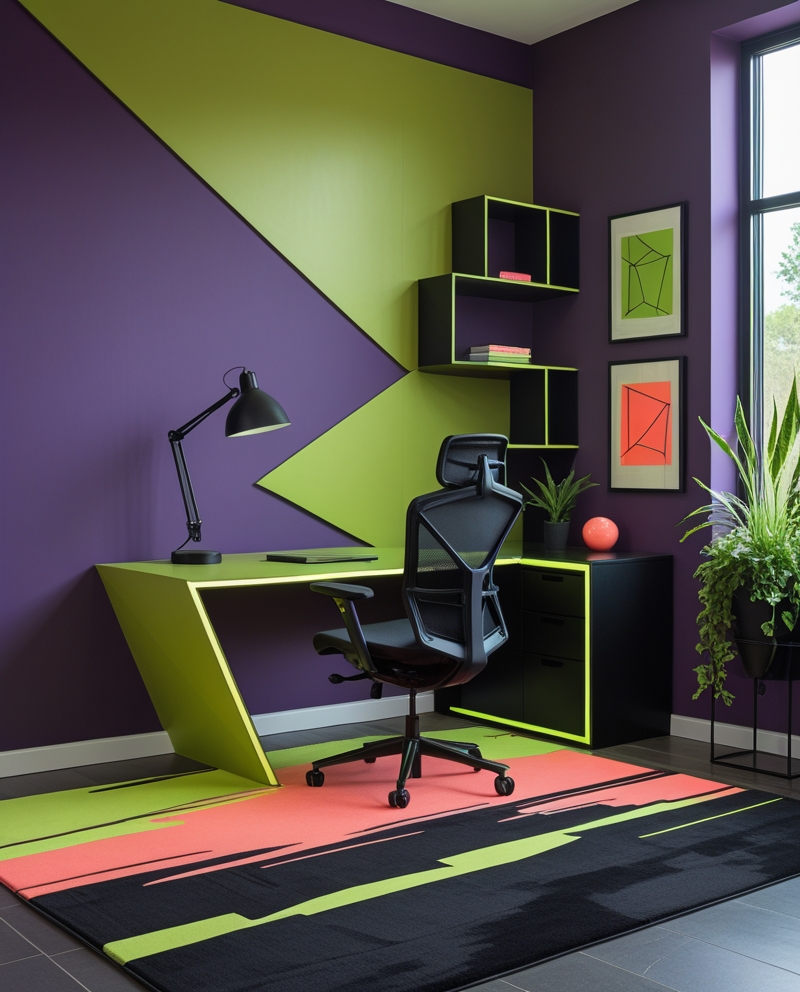
Choosing a Surrealist Color Palette
You know that feeling when you see a color combination that stops you in your tracks? That’s exactly what we’re aiming for with surrealist design. But here’s the thing – creating those jaw-dropping moments isn’t about throwing every bold color at the wall and hoping something sticks. It’s about being strategic with your color choices to create that perfect balance of dramatic and dreamy.
Bold vs. Neutral: Finding Your Base
Let me share something I’ve learned through countless color experiments: surrealist design actually shines brightest when you give those bold moments room to breathe. Here are some tried-and-true palettes that never fail to create that surreal vibe:
- The Dream Sequence
- Deep midnight blue (#1B1B3A)
- Cloud white (#F7F7FF)
- Ethereal silver (#C0C0C0)
- Accent: Electric purple (#9B4DCA)
- The Salvador
- Desert sand (#E5C5A5)
- Sky blue (#89CFF0)
- Rich terracotta (#A0522D)
- Accent: Molten gold (#FFD700)
- The Modern Mystic
- Charcoal black (#2F2F2F)
- Moonlight grey (#E8E8E8)
- Pearl white (#FCFCFC)
- Accent: Emerald green (#50C878)
Playing with Metallics and Reflective Surfaces
Here’s a little secret: metallics aren’t just colors – they’re mood-makers. I once used a copper accent wall (#B87333) against a deep teal (#008080), and the way it shifted throughout the day was like having different rooms without changing a thing. Try these combinations:
- Morning Shimmer
- Brushed gold (#DAA520)
- Rose gold (#B76E79)
- Matte black (#2C2C2C)
- Twilight Gleam
- Platinum (#E5E4E2)
- Gunmetal (#2C3539)
- Pearl white (#FCFCFC)
Creating Emotional Impact
The psychology of color takes on a whole new meaning in surrealist design. It’s not just about how colors make you feel – it’s about how unexpected combinations can create entirely new emotional experiences:
- For Dream-Like Calm
- Lavender mist (#E6E6FA)
- Deep sea blue (#006994)
- Cloud white (#F7F7FF)
- Accent: Moonstone (#7FCDCD)
- For Creative Energy
- Electric lime (#CCFF00)
- Deep purple (#301934)
- Cosmic black (#202020)
- Accent: Neon coral (#FF6F61)
Remember, these aren’t rigid rules – they’re starting points. The best surrealist spaces often break color “rules” in the most delightful ways. Start with one of these palettes, then trust your instincts to add that unexpected twist that makes it uniquely yours. And if you’re ever in doubt? Grab some paint samples and create a small test area. Sometimes the most surprising combinations end up being the most magical.
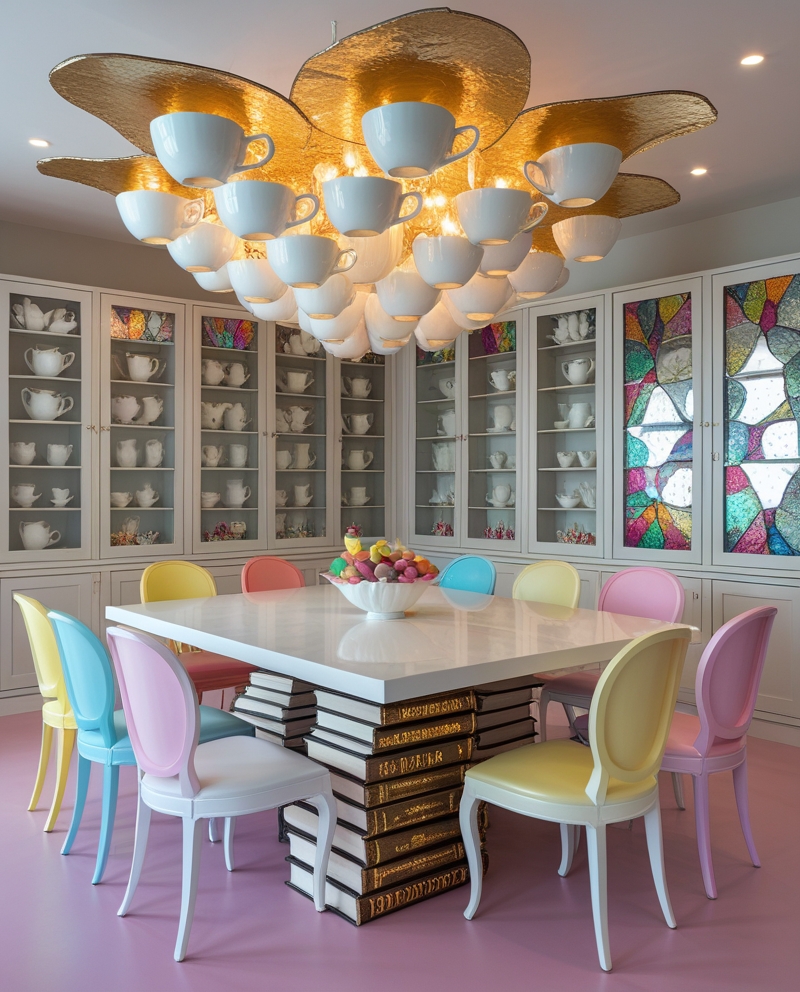
Furniture That Feels Like Art
Let me tell you about my first encounter with a truly surreal furniture piece – it was a bookshelf that looked like it was being pulled by an invisible force, books cascading along its warped surface. I remember thinking, “This is either brilliant or completely impractical.” Turns out, it was both, and that’s exactly what made it perfect for the right space.
When Furniture Breaks the Rules
Here’s what I’ve learned about choosing statement pieces that double as functional art: it’s all about finding that sweet spot between “wow” and “wow, I can actually use this.” Some of my favorite discoveries include:
- Chairs that play with gravity: Think floating seats suspended by clear acrylic or seats that appear to balance on impossible angles – but are secretly engineered for perfect stability
- Tables that tell stories: Like coffee tables with built-in miniature landscapes or dining tables with surfaces that look like liquid metal frozen in time
- Storage that surprises: Cabinets that seem to melt into walls or shelving units that create optical illusions while still holding your books perfectly level
Ready-Made vs. Custom: The Real Talk
Let’s have an honest conversation about budget and accessibility. While custom pieces can be absolutely mind-blowing, they often come with equally mind-blowing price tags. Here’s what I’ve discovered works:
- Ready-made winners: Many mainstream furniture makers are embracing surrealist design elements. Look for:
- Modular pieces that can be arranged in unexpected ways
- Limited edition collections from major retailers
- Collaborative pieces between artists and furniture brands
- Custom route considerations:
- Start with smaller pieces like side tables or mirrors
- Work with local artisans who might be more affordable than big-name designers
- Consider semi-custom options where you can modify existing designs
Making It Work in Real Life
Remember that time I fell in love with a chair that looked like a cloud but turned out to be about as comfortable as sitting on, well, an actual cloud? Learn from my mistake! Here’s how to balance the fantastic with the functional:
- Test before you commit: If possible, interact with the piece in person. That sculptural dining chair needs to actually work for dinner parties
- Consider the daily routine: A surreal coffee table shouldn’t make it impossible to set down your actual coffee
- Think about maintenance: That mirror-polished surface might look amazing, but can you live with wiping fingerprints off it daily?
The best part about surrealist furniture is that even one piece can transform an entire room. I’ve seen a single statement chair turn a boring corner into everyone’s favorite conversation spot. Start with something that makes you smile every time you look at it – that’s usually a good sign you’ve found the right balance between art and function.
Remember: your furniture should still serve its purpose, even if it looks like it just walked out of a dream. After all, the best surrealist pieces aren’t just conversation starters – they’re conversation starters you can actually sit on.
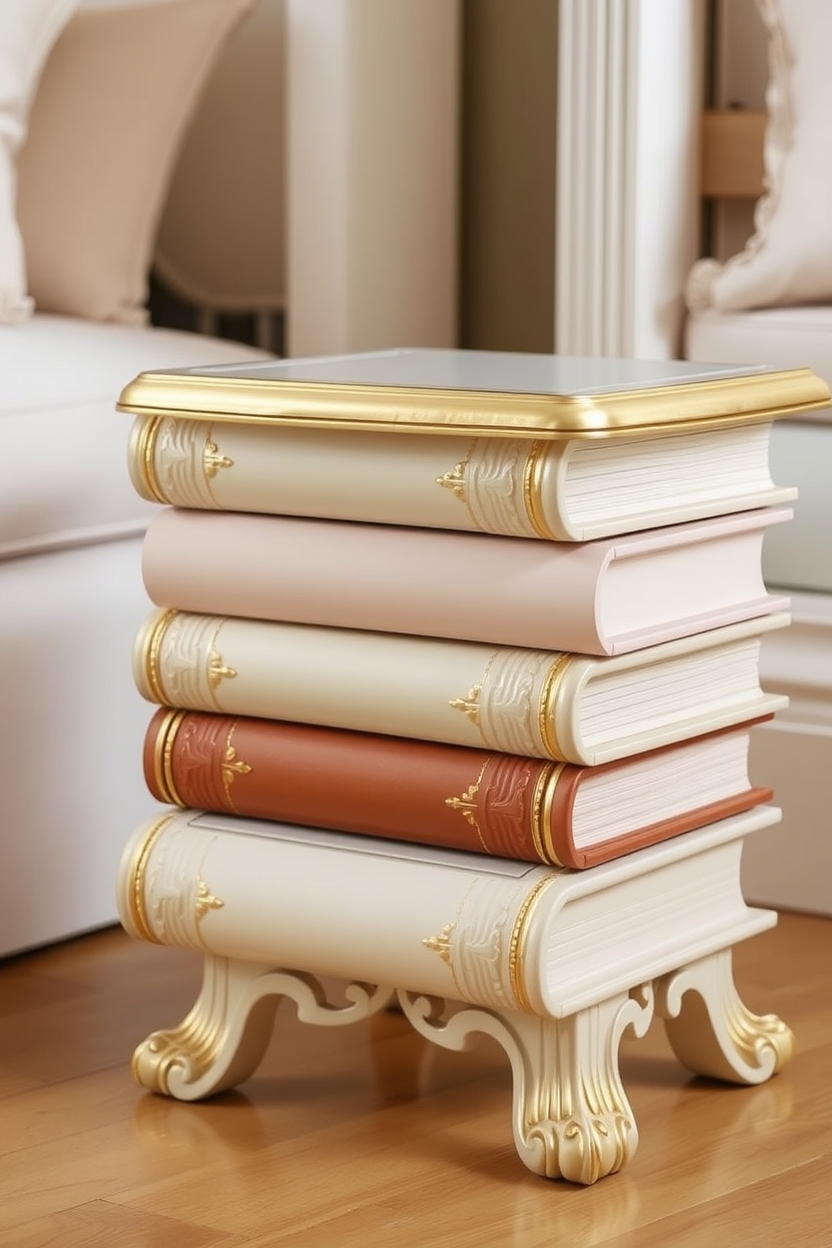
Incorporating Surreal Decor Pieces
You know that moment when you’re scrolling through Pinterest late at night and suddenly stop at an image that makes you think, “Wait… what am I looking at?” That’s the sweet spot we’re aiming for with surreal decor. I’ll never forget the time I hung a mirror that made it look like my ceiling went on forever – my cat spent weeks trying to figure that one out!
Art That Makes You Think Twice
Here’s something I’ve learned after years of experimenting with surreal decor: sometimes the simplest tricks create the biggest impact. You don’t need to recreate Magritte’s floating men in bowler hats (though how fun would that be?). Instead, try:
- Playing with perception: I once used a trompe l’oeil wallpaper that made it look like my wall was peeling away to reveal a garden. Guests still try to touch it to check if it’s real
- Mixing dimensions: Try combining 2D and 3D elements – like a flat art piece that extends into a real, physical object
- Creating unexpected focal points: Maybe it’s a classic portrait painting where the subject is wearing modern sunglasses, or a traditional landscape that morphs into geometric shapes
The Magic of Mirrors and Textiles
Let me tell you about my favorite design happy accident. I placed two mirrors at an angle, intending to make my room look bigger, but ended up creating this incredible kaleidoscope effect. That taught me that sometimes the best surreal moments happen when you’re willing to play. Try these tricks:
- Mirrors that tell stories:
- Use convex or concave mirrors to distort reality in interesting ways
- Layer multiple mirrors to create infinite reflections
- Install mirrors in unexpected places (like a ceiling panel peeking through a “broken” wall)
- Textiles that transport:
- Rugs with patterns that seem to move when you walk past them
- Curtains printed with images that change depending on how they’re draped
- Throw pillows with optical illusions or perspective-bending designs
Creating Layers of Wonder
Here’s a secret I wish I’d known earlier: surreal decor works best when it reveals itself gradually. Think of it like a good story – you want some plot twists, but you don’t want to give everything away in the first chapter. In my own space, I love creating these layers:
- Start with a foundation piece: Maybe it’s that mind-bending rug you fell in love with
- Add vertical interest: Layer wall art that plays with perspective
- Include unexpected moments: Like a “floating” shelf that’s actually secured invisibly
- Finish with playful accessories: Small surreal touches that reveal themselves only upon closer inspection
Remember, the goal isn’t to make your space look like a modern art museum (unless that’s your thing!). It’s about creating moments of delight and surprise that make you smile every time you notice them. And trust me, there’s nothing better than watching a guest discover that what they thought was a regular bookend is actually a tiny door to nowhere!
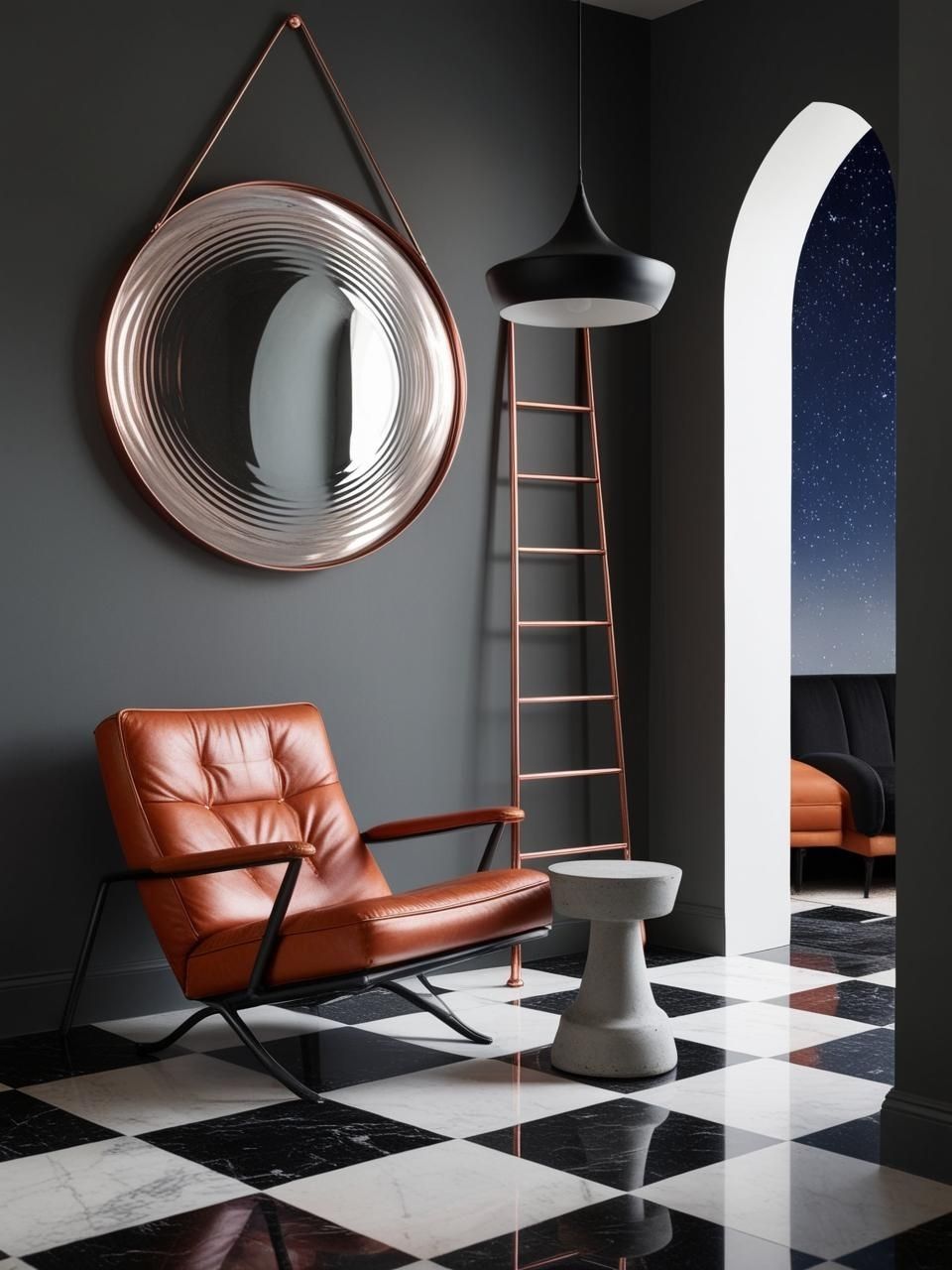
Surrealism in Small Spaces
Oh, small spaces – they’re like the ultimate design puzzle, aren’t they? I learned this firsthand when I moved from a spacious loft to a cozy studio. At first, I thought I’d have to leave my surrealist dreams behind (along with my oversized art collection). But here’s the thing: sometimes constraints actually fuel creativity. Let me share what I’ve discovered about making surrealism work in spaces where every inch counts.
Small But Mighty: Making an Impact
You know how they say good things come in small packages? That’s especially true with surrealist design. In fact, I’ve found that smaller spaces can actually make surreal elements pack more punch. Here’s why:
- The element of surprise is more immediate: When you have a tighter space, every piece gets its moment to shine
- Forced perspective becomes your friend: Small spaces let you play with scale in really interesting ways
- Focused impact means you can be more intentional: Think of it like seasoning a small dish versus a huge pot of soup
Clever Tricks for Apartment Living
Let me tell you about my favorite tiny-space discovery: I installed a mirror that looks like a window, but the “view” is of clouds floating by. It completely transformed my windowless bathroom from claustrophobic to whimsical. Here are some other space-savvy surrealist moves:
- Use vertical space creatively:
- Install floating shelves that look like they’re climbing up your wall like stairs
- Try a wall mural that creates the illusion of extended space
- Mount lighting fixtures that cast unexpected shadows
- Play with scale strategically:
- One oversized piece can actually make a room feel larger (I know, counterintuitive!)
- Use miniatures in unexpected places to create delightful moments
- Choose pieces that play with proportion but don’t eat up floor space
Double-Duty Designs That Delight
Remember that time I bought a gorgeous sculptural chair that took up half my living room? Yeah, learn from my mistake! In small spaces, surreal pieces need to earn their keep. My current favorites are:
- A coffee table that looks like it’s balancing on bubbles but actually has hidden storage inside
- A mirror that doubles as art, with a frame that seems to melt into a shelf
- A room divider that creates different patterns depending on which side you’re viewing it from
The secret to surrealism in small spaces? Think of your room like a jewelry box – it might be compact, but each piece inside can be absolutely magical. Start with one statement piece that makes you smile, then build around it with smaller surreal touches that don’t compete for attention or precious square footage.
And here’s my favorite tip: if you’re not sure about a piece, tape out its footprint on your floor first. I learned this after my “bubble chair” incident – turns out, measuring with your eyes isn’t actually a thing! Sometimes the most surreal part of small-space design is figuring out how to make it all fit, but trust me, when you get it right, it’s like living in your own little wonderland.
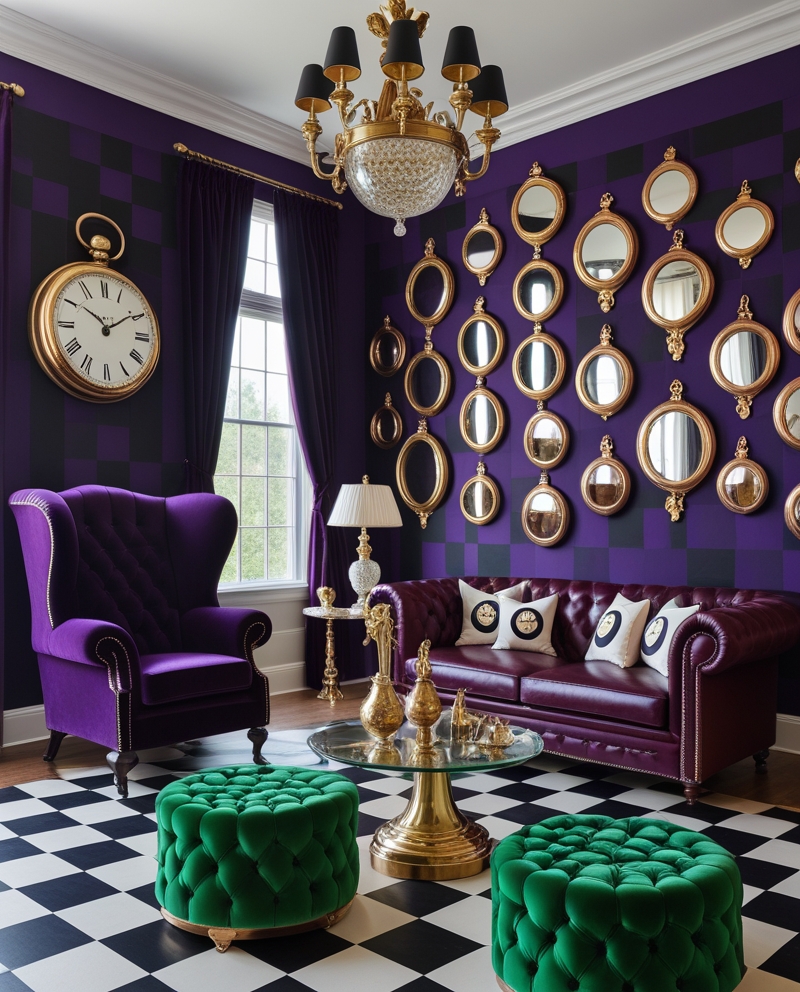
Lighting: Setting the Surreal Mood
Let me share a quick story: I once installed this gorgeous sculptural light fixture that cast the most amazing shadows on my walls. I was feeling pretty pleased with myself until I realized I’d forgotten one tiny detail – I couldn’t actually read in my living room anymore! But you know what? That “oops” moment taught me something valuable about balancing drama with practicality in lighting design.
Statement Lighting That Steals the Show
Here’s the thing about surreal lighting – it’s not just about illuminating a space; it’s about creating moments that make you question reality (while still being able to find your keys). My current obsession is sculptural fixtures that look different from every angle:
- Cloud-like pendant lights that seem to float and shift
- Wall sconces that look like they’re emerging from the surface
- Floor lamps that bend in impossible ways but are perfectly balanced
Pro tip: Before you fall head over heels for that amazing statement piece (like I did with my shadow-casting beauty), remember to layer in some practical lighting too. Trust me, your eyes will thank you later!
Shadow Play: The Free Light Show
Want to hear something cool? My favorite lighting trick actually cost nothing – it was all about positioning. I discovered that placing a simple geometric lamp near a textured wall created this incredible pattern that looks like a moving art piece. Here’s how you can play with shadows:
- Position lights at different angles to create layered shadows
- Use perforated lampshades for intricate shadow patterns
- Place lights near reflective surfaces to double the impact
The Color Story
Remember my first experiment with colored lighting? I went full disco-technicolor (it was a phase, okay?). Now I know that subtle is usually better when it comes to colored lighting in surreal design. Here’s what actually works:
- Start with dimmable smart bulbs that can shift from practical white light to moody colors
- Use colored light in unexpected places (like under a floating shelf or behind a mirror)
- Layer different color temperatures to create depth
My favorite combination right now is mixing warm amber light with cool blue-tinted shadows – it creates this dreamy twilight effect that makes everyday objects look almost magical.
Quick Reality Check
Look, I’ve learned that the most successful surreal lighting designs are the ones that know when to show off and when to chill out. You want your space to feel like an art installation sometimes, but you also need to be able to find your phone when it falls between the couch cushions!
Start with one statement piece that makes your heart skip a beat, then build around it with more practical layers. And remember – the best lighting scheme is one that can adapt to different moods and needs. Because sometimes you want to feel like you’re living in a René Magritte painting, and sometimes you just need to see what you’re cooking for dinner!
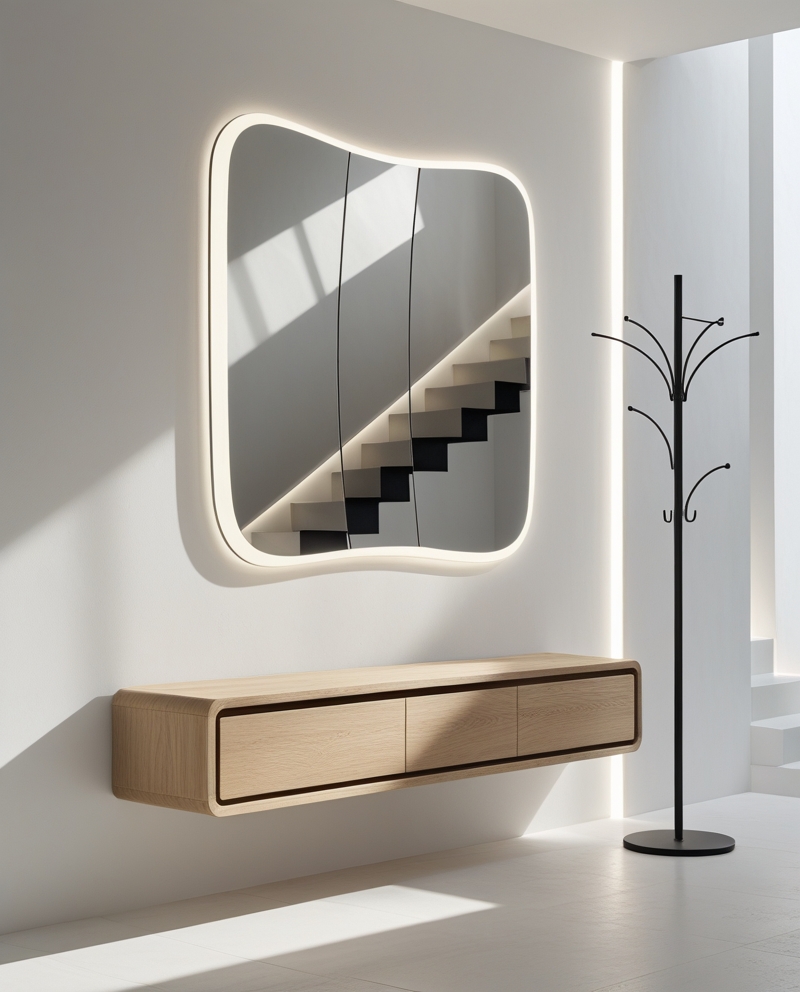
Mixing Surrealism with Other Styles
You know that moment when you realize your minimalist living room is actually crying out for a chair that looks like it’s made of clouds? That was my design awakening. For the longest time, I thought mixing surrealism with other styles would look like I’d accidentally stumbled into two different showrooms. Spoiler alert: when done thoughtfully, it’s actually pure magic!
When Minimalism Meets Dreams
Here’s a confession: I used to think minimalism and surrealism were like oil and water – they just wouldn’t mix. But then I placed a single surreal piece (a mirror that looks like it’s melting) against a crisp white wall, and suddenly it all made sense. The clean backdrop actually made the surreal element more powerful. Who knew?
- Start with a minimalist foundation:
- Keep your main pieces clean-lined and simple
- Stick to a limited color palette
- Let negative space do some of the heavy lifting
- Add surreal elements strategically:
- Choose one statement piece that breaks reality
- Use unexpected proportions in otherwise simple pieces
- Play with materials (like a concrete chair that looks soft)
The Bohemian Dream Merger
Talk about a fun combination! Mixing surrealism with bohemian style is like hosting a party where Salvador Dalí meets your free-spirited aunt who collects vintage textiles. Here’s what I’ve learned works beautifully:
- Layer patterns with purpose:
- Mix dreamlike prints with traditional bohemian patterns
- Use surreal artwork alongside natural textures
- Play with scale in unexpected ways
Remember that time I combined a traditional Moroccan rug with a coffee table that looked like it was floating on bubbles? My friends thought I’d lost it – until they saw how the organic patterns in the rug actually made the surreal element feel more grounded. Sometimes the wildest combinations make the most sense!
Finding Your Balance
Here’s the thing about mixing styles: there’s no rulebook (trust me, I’ve looked!). But after years of experimenting, I’ve found some approaches that rarely fail:
- Start with what you love:
- Keep your favorite “normal” pieces
- Add surreal elements that speak to you
- Don’t force combinations that don’t feel right
- Create conversation between styles:
- Use color to bridge different elements
- Play with textures that complement each other
- Let one style take the lead while the other supports
I once had a client who was scared to mix her beloved mid-century modern collection with surrealist pieces. We started small – just a subtly surreal lamp here, a slightly twisted side table there. Now her space feels uniquely her: grounded in familiar design but with moments of pure wonder that make you smile.
Remember, at the end of the day, your space should feel like you – just maybe a slightly more imaginative version of you! And if someone walks into your room and says, “I’ve never seen anything quite like this before,” well, that’s when you know you’ve nailed it.

Surrealism in Outdoor Spaces
Okay, can we talk about that time I installed a giant mirror ball in my garden, thinking it would be this amazing surreal element, only to discover it was basically a death ray for my poor plants when the sun hit it? Classic learning moment! But here’s the thing – bringing surrealism outdoors can be absolutely magical when you work with nature instead of accidentally trying to fry it.
Nature’s Built-In Surrealism
You know what I’ve discovered? Mother Nature is actually the original surrealist. Think about it: have you ever really looked at a birds of paradise flower? Or watched how shadows dance through leaves? We just need to amplify that natural wonder:
- Play with perspective:
- Create pathways that seem to lead nowhere (but actually loop around beautifully)
- Use mirrors strategically (just, um, check the sun’s path first)
- Plant things in unexpected places, like herbs growing out of vertical walls
Making Magic with Outdoor Furniture
Let me tell you about my current favorite outdoor setup – I found these chairs that look like they’re melting into the ground, but they’re actually the most comfortable things ever. Here’s what I’ve learned about surreal outdoor furniture:
- Choose pieces that can handle the elements:
- Weather-resistant materials that still look dreamlike
- Sculptural pieces that double as shelter from sun or rain
- Furniture that plays with light and shadow throughout the day
True story: I once had a client who wanted their pool furniture to look like it was floating. We ended up creating these amazing lucite pieces that, when the light hits them just right, disappear completely. The effect is incredible – though we did have to add some subtle markers so people don’t accidentally sit in the pool!
Lighting the Night Fantastic
Night time is when outdoor surrealism really shines (pun absolutely intended). After my mirror ball fiasco, I got really into experimenting with lighting that creates magical effects after dark:
- String lights arranged in impossible geometric patterns
- Solar-powered fixtures that create moving shadows
- Ground lighting that makes plants look like they’re floating
Pro tip: Layer your lighting just like you would indoors. I learned this after creating what my neighbors kindly called a “UFO landing pad” effect with too many spotlights. Now I mix subtle pathway lights with more dramatic feature lighting, and the result is much more enchanting.
Blending the Lines
Here’s my favorite part about outdoor surrealism – there’s something so special about that moment when guests can’t quite tell what’s natural and what’s designed. I had this amazing accident happen when some morning glory vines decided to climb up my sculptural garden arch. The way they wove through the metalwork created this living, breathing surreal element that changed every day.
Remember, outdoor spaces are constantly changing with the seasons, weather, and time of day. Work with these changes instead of against them. And maybe double-check where that mirror ball is going to reflect before you install it. Not that I’m still thinking about that or anything…
Want to dip your toe in? Start with one statement piece – maybe a bench that looks like it’s being pulled into the ground, or a pathway that seems to float above your garden. Then let nature do what it does best: add its own little bits of magic to your surreal outdoor wonderland.
Unlock Designer-Perfect Colors in Minutes
Browse my curated collection of interior color palettes—tailored for today’s most loved design styles.
Designing Your Dreamlike Home: Final Tips
Let me share something that took me way too long to learn: you don’t have to transform your entire home into a Salvador Dalí painting overnight! Remember my first attempt at surreal design? I went all in – floating furniture, melting mirrors, the works. My poor dog wouldn’t enter the living room for a week! Now I know better, and I’m here to save you from my overzealous beginner mistakes.
Starting Small (But Dreaming Big)
Think of surreal design like dipping your toes into a really fantastic dream. You don’t have to dive headfirst into the deep end:
- Begin with one conversation piece:
- Maybe it’s just that one incredible lamp that looks like it’s defying gravity
- Or a mirror that makes people do a double-take
- Even a simple throw pillow with an impossible pattern can start the surreal journey
I had this client who was nervous about going surreal, so we started with just one piece – a side table that looked like it was balancing on bubbles. Now it’s her favorite thing to show visitors, and guess what? She’s ready for more!
Investment Pieces That Make Sense
Look, I’ll be the first to admit I’ve made some… interesting choices when it comes to statement pieces. Remember that chair I mentioned that looked amazing but was about as comfortable as sitting on a cloud? Yeah, let’s learn from my mistakes:
- Choose pieces that:
- Tell a story but still serve their purpose
- Make impact without overwhelming your daily life
- Can evolve with your style over time
Pro tip: Before investing in that amazing but pricey surreal sofa, try living with the idea for a while. I actually create little paper mockups now (after the cloud chair incident) to help visualize how a piece will really feel in a space.
Working With a Designer (Without Losing Your Vision)
Here’s a funny thing about working with designers – sometimes we get so excited about creating something wild and wonderful that we forget people actually need to live in these spaces! When I’m working with clients now, I always start by asking about their comfort zone and then gently pushing just one step beyond it.
If you’re thinking about working with a designer:
- Share your inspiration but also your fears
- Be clear about your daily needs
- Don’t be afraid to say “that’s too much” or “can we go bigger?”
- Ask for a test run with smaller pieces first
Remember, at the end of the day, your home should feel like you – just maybe a slightly more imaginative version of you. Start small, dream big, and don’t be afraid to laugh at the occasional design mishap along the way. After all, isn’t that what surrealism is all about? Breaking the rules, having fun, and creating spaces that make people smile?
And hey, if you end up with a cloud chair that no one can sit in? At least it’ll make a great story at your next dinner party. Speaking of which, make sure your dining chairs are actually functional – trust me on this one!
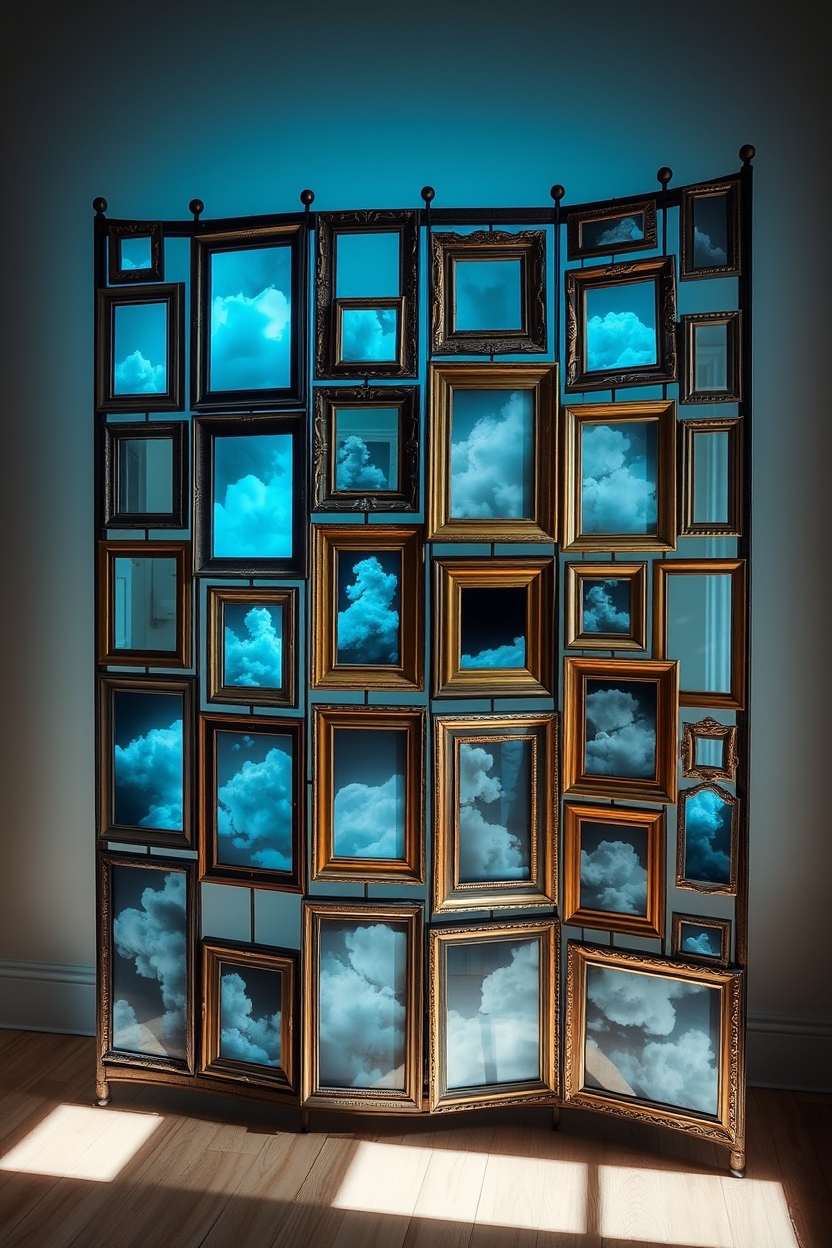
In Conclusion
You know what I love most about modern surrealism in interior design? It’s not just about creating spaces that make people say “wow” – though that’s definitely a fun bonus! It’s about giving yourself permission to break the rules, to play with reality, and to create a home that tells your unique story in the most imaginative way possible.
Throughout this journey, we’ve explored everything from floating furniture to mind-bending lighting, from color palettes that spark joy to outdoor spaces that blur the lines between reality and dreams. And here’s what I’ve learned: there’s no single “right” way to do surreal design. Your version might be a subtle optical illusion in your entryway, or maybe it’s a full-on wonderland complete with upside-down furniture (just make sure you can still find your keys!).
Remember that client I mentioned who started with just one surreal piece and ended up transforming her entire space? She told me something that really stuck with me: “It’s not about making my home look like an art gallery – it’s about creating moments that make me smile every single day.” And isn’t that what great design is all about?
Whether you’re dipping your toes in with a mysteriously floating shelf or diving headfirst into a full surrealist renovation, just remember – start with what speaks to you, keep function in mind (learned that one the hard way!), and don’t be afraid to experiment. After all, in a world of beige boxes and matching sets, a little bit of surreal magic might be exactly what your space needs.
Now, go forth and create something wonderfully, beautifully unexpected. And if you end up with a chair that looks like it’s melting? Own it. Some of the best design stories start with “I wasn’t sure about this at first, but…”
Curated Wall Art for Elegant Homes
Bring softness, texture, and intention into your home with digital wall art inspired by wabi-sabi, abstract forms, and muted watercolors. Every piece is crafted to create stillness and beauty—whether you’re styling a gallery wall or a minimalist nook.